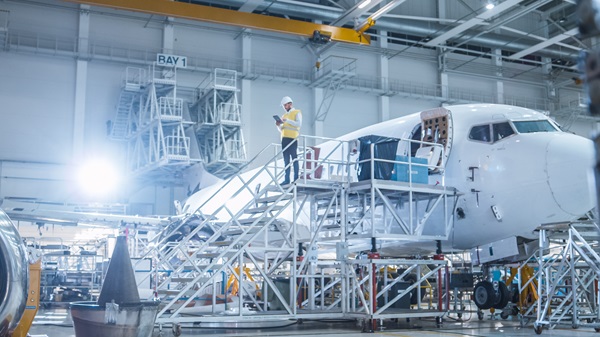Optimizing Aerospace Supply Chain With AI and Big Data

INTRODUCTION: TRANSFORMING THE PROCUREMENT PROCESS WITH AI
The aerospace supply chain is a complex system of multiple global suppliers that produce components across the entire aircraft ecosystem - frame, engine, integrated systems, etc. This system requires a robust management strategy for improved supply chain visibility, enabling airlines, OEMs, MROs, and parts distributors to make informed purchasing decisions while effectively mitigating compliance risks.
A single aircraft can contain hundreds of thousands or even millions of parts. The number of parts an airline, OEM, or MRO shop must keep track of exponentially increases for an entire fleet comprised of different platforms. A single commercial aircraft can have up to 3 million parts, emphasizing the complexity of inventory management. With multiple global suppliers and part distributors making or selling parts, procurement becomes a complicated, data-intensive process, where millions of dynamic data points need to be analyzed.
Current part websites or digital marketplaces are not sophisticated enough to parse or extract relevant information from extensive and dynamic datasets. Significant manual effort is needed to verify that parts meet requirements, are priced at fair market value, and are available – making the procurement process arduous.
Such long decision cycles can impact the operational and financial performance of OEMs, airlines, MRO shops, and part distributors. Boeing estimates Aircraft on Ground (AOG) costs an airline $10,000 to $20,000 dollars per hour, or even as much as $100,000 in lost revenue and additional expenses, depending on the situation at hand. In 2018, Airline Economics found that AOG events cost the global airline industry an estimated US $50 billion annually.
Being able to sift and analyze large volumes – such as millions of parts and their associated data - of information and produce a recommendation quickly is a prime application for automation technology, such as Artificial Intelligence (AI), within the aerospace industry. AI can transform the intricate web of supply chain transactions into a streamlined, efficient, and cost-saving operation—allowing you to not only manage but also optimize the entire supply chain in real-time.
AI models like Recurrent Neural Networks (RNNs) and Transformers analyze sequential data trends, enabling timely decision-making in procurement.
With more data, time, and training, these aviation specific AI models will become more accurate and efficient. Trained on aviation data over the past few years, these models achieve high accuracy metrics, including R², indicating the precision of predictions. AI systems are designed to be self-learning and self-optimizing, continuously improving their performance based on new data inputs.
In this white paper, you will learn how AI technology can optimize the procurement process within the aerospace industry leading to increased operational and financial performance.

HARNESSING THE POWER OF BIG DATA WITH BLOCKCHAIN AND AI TECHNOLOGY
Aerospace does not lack data; it could even be categorized as the common denominator across industry segments. However, data is only as valuable as the insights it can provide and the action it inspires an organization to take.
Collecting and analyzing high volumes of data and producing recommendations is the perfect use case for a solution that incorporates AI supported by blockchain technology. Advanced models, such as Graph Neural Networks (GNNs), facilitate understanding of relationships between suppliers and parts, enhancing decision-making within blockchain-enabled systems.
The decentralized nature of a blockchain system enables real-time, industry-wide searches using public, third-party, and internal data in a matter of seconds. Filter those results into an AI model, instantly an accurate solution is devised — creating efficiencies across an organization by streamlining and automating a very manual process.
ePlaneAI recognized this use case and developed a software-as-a-service platform that uses conversational and generative AI alongside big data to fully automate the aerospace part industry and procurement process.
Each part record within the blockchain contains an immutable history of attributes—such as condition, location, and compliance—providing a secure, tamper-proof digital record that mitigates counterfeit risks, increases transparency, and bolsters compliance with industry regulations like EASA and FAA.
As the results of a part search are collated, they then go through the generative AI model, producing a customized recommendation that is automated and self-adjusting based on real-time aerospace market data. Any changes in cost, location, or availability of a part are factored into the recommended solution. So, if you search for Part A on a Monday morning but don’t purchase it until Tuesday, it may not be available, or the reflected price might have changed—like delaying a purchase in your Amazon cart.
AI’s inherent ability to handle large datasets (and types) and adapt to varying patterns and production complexities ensures long-term sustainability and scalability. With the global MRO market projected to reach $119 billion by 2026, and labor costs accounting for 60-70% of total MRO expenses, efficient AI solutions can significantly drive cost savings and operational efficiencies.
To support AI’s growing data demands, ultra-fast databases are essential. Traditional databases often lack the speed and scalability required for real-time data processing, making advanced database technologies critical for successful AI implementation. The cost of cloud computing itself can range from $0.25 per hour to over $30 per hour for high-end single GPU systems. However, these technologies are scalable and accessible to businesses of all sizes, including smaller operations. AI’s capabilities can be tailored to fit specific needs for all to reap immediate benefits.
Larger enterprises can expect even greater efficiencies and cost savings as they leverage continuous AI-driven insights across massive datasets. Modern databases capable of sub-second query response times enable AI solutions to deliver faster and more accurate recommendations for inventory management to remediating AOG situations.
With a vast and constant amount of data being collected and processed through ePlaneAI’s solution, the AI technology consistently improves with time and training. The more patterns and trends it can identify based on the increased amount of data, the better it can generate a preferred solution for the user.
INSIGHTS BEYOND HUMAN ANALYSIS
The terabytes of aircraft part data that can be consumed and processed would take hundreds of data scientists months to produce actionable results. However, one of the key bottlenecks in AI-driven decision-making is the database infrastructure. While some databases can process queries in <1 second, others may take up to 15 minutes to deliver the same results. This delay can significantly impact real-time decision-making in critical procurement scenarios, where speed is essential for maintaining operational efficiency to minimize financial impact. For instance, each commercial aircraft undergoes around 3-5 major maintenance events annually, with average maintenance costs per aircraft reaching $3 million.
Part delays and unplanned maintenance can lead to premium costs, loss of future ticket sales from extended downtime, and decreased customer loyalty due to increased delays and cancellations.
Having internal resources diverted from daily operational tasks during to searching inventory stock or ordering parts and making critical decisions quickly with limited information causes further operational disruption.
The ePlaneAI platform uses Convolutional Neural Networks (CNNs) for identifying image-based part data and Autoencoders for anomaly detection, ensuring data accuracy and quality assurance. These models operate autonomously, adjusting to evolving data patterns to maintain high accuracy and performance over time. This autonomous capability reduces human intervention and increases operational efficiency. By leveraging this type of solution, organizations will have a better understanding of inventory stock and utilization, which enables accurate forecasting of short and long term needs to mitigate future inventory issues. The solution can automatically purchase stock at the best available market price.

USE CASE: Automated Procurement and Inventory Optimization
An aviation industry company faced significant challenges with AOG orders which accounted for 70% of their total part orders. These involved over 500 vendors and managing over 70,000 SKUs across five warehouses. Their par level optimization occurred infrequently, only once a year, which led to inefficiencies and pressure on employees to make critical decisions. On average, airlines aim for an inventory turnover rate of 1.5 to 2 times per year, meaning that parts inventory is typically replaced every 6-8 months.
This company implemented a custom solution from ePlaneAI that used XGBoost and Random Forests to optimize procurement schedules and inventory management, ensuring precise par-level adjustments and demand forecasting. Specific results included:
- Over 37% of inventory identified as stale, allowing for better utilization of stock.
- Achieved over 95% accuracy in forecasting and predicting short-term demand, leading to more precise purchasing decisions.
- Improved labor efficiency by 65%
- Substantial decrease in AOG incidents and reduced purchases of premium AOG parts
Even when only leveraging internal ERP data an AI solution can become more predictive based on user preferences. For example, being able to leverage historical purchasing decisions – quantities, vendors, rate of delivery trains the AI model to generate not only the best decision, but also a preferred solution.
USE CASE: Long-Term Forecasting and Production Scheduling
An aerospace part manufacturer faced significant challenges due to long lead times exceeding eight months and short delivery windows ranging from 1 to 10 days. These constraints necessitated a robust solution to forecast demand accurately and plan production effectively.
They implemented a custom AI solution from ePlaneAI to accurately forecast and identify patterns and seasonal trends and inform a comprehensive yearly production schedule including upper, lower, and median values.
Models like Prophet and ARIMA enable accurate demand prediction, while Genetic Algorithms optimize production schedules based on seasonal trends.
Specific results included:
- Identified that 40% of parts were not moving, which ultimately led to the company discontinuing production for those items in the next year, contributing to overall cost savings.
- Achieved 82% accuracy at the part number level and 90% accuracy at the quantity level for parts requiring production.
Enabled the client to optimize production processes, reduce unnecessary manufacturing and meet delivery deadlines more effectively.

AUTOMATED PROCESSES FROM INSIGHT TO TRANSACTION
ePlaneAI automatically guides the user to complete the transaction once a recommendation is provided. By integrating Reinforcement Learning (RL), the system adapts to dynamic market conditions, enabling real-time pricing adjustments for procurement transactions. These adaptive algorithms operate in an autonomous mode, requiring minimal manual intervention while maximizing efficiency and cost-effectiveness. This is achieved through the autonomous storefront which provides automated pricing – adjusted to the current market rate - and a global B2B checkout & payment system based on contract terms.
Automating this process enables increase operational efficiency and performance and, thus, profitability through:
- Less manual intervention, shorter lead times, and automatically purchasing inventory at the best available price.
- Scaling for various volumes without straining internal resources.
- Improved accuracy and consistency of inventory records
- Stronger relationships with suppliers through timely supplier payments.
Automated transactions also create digital, detailed logs that facilitate traceability as an enhanced compliance measure. These detailed records also ensure the transaction meets all necessary purchasing process guidelines.
Automating the transaction process is the final step of facilitating a more streamlined and effective procurement strategy.
CONCLUSION
A more simplified and effective procurement strategy leads to increased operational efficiency and, ultimately, a more profitable company.
For each segment of the aerospace industry to maintain a competitive advantage and increase its profitability, they need to embrace technologies that optimize the complex, labor and time intensive procurement process. Considering that inventory holding costs in the aviation industry ranging from 15-25% of the part’s value per year, AI-driven inventory optimization can yield substantial savings.




